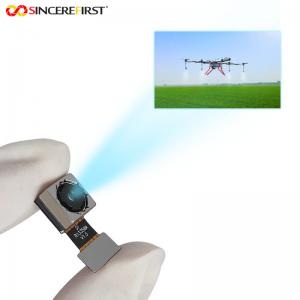

Add to Cart
Hd 13mp Auto Focus DFOV78.4 AR1335 Cmos Sensor FPV Mipi Camera Module
Specificaitons
| Sensor | AR1335 |
| Focus Type | Auto Focus |
| Pixel | 13MP |
| Focusing Range | 10cm~Infinity |
| Connector | AXT630124 |
| Output Format | RAW 10 bits |
| VCM Driver | WV511A |
| Sensor Color | Color |
| Interface | MIPI |
| Sensor Type | 1/3.2" |
Description
The AR1335 is a 1/3.2-inch BSI (Back Side Illuminated) CMOS
active-pixel digital image sensor with a pixel array of 4208 (H) ×
3120 (V) . It is manufactured by ON Semiconductor and is used in
several devices such as the Raspberry Pi High Quality Camera.
The AR1335 is a progressive-scan sensor that generates a stream of
pixel data at a constant frame rate. It uses an on-chip,
phase-locked loop (PLL) to generate all internal clocks from a
single master input clock running between 6 and 48 MHz. The maximum
data rate is 1.2 Gbps per lane.
Features
The AR1335 is a 1/3.2-inch BSI (Back Side Illuminated) CMOS
active-pixel digital image sensor with a pixel array of 4208 (H) ×
3120 (V). It is manufactured by ON Semiconductor and is used in
several devices such as the Raspberry Pi High Quality Camera.
Here are some of the features of the AR1335 image sensor:
Pixel size: 1.1um x 1.1um
Resolution: 4160×3120
Optical size: 1/3″
Lens Spec: M12 Low distortion lens, EFL: 4.73mm, FoV (H): 50°,
F/NO:2.2
Max Data Rate: 1.2Gbps/laneFrame Rate: 7fps@4160 ×3120, 11fps@3264
×2448/3840×2160, 24fps@2560 ×1440, 30fps@1600
×1200/1920×1080/640×480/320×240
Responsivity: 4.7k e/lux-sec
SNR (Max): 37dB
Applicaitons
The AR1335 image sensor is used in several devices such as
smartphones, drones, sports action cameras, IoT cameras, and
high-resolution imaging devices. It is also used in the Raspberry
Pi High Quality Camera.
Here are some of the applications of the AR1335 image sensor:
4K video recording and streaming
Body cameras
IoT cameras
Drones
Sports action cameras
High-resolution imaging
FPV
FAQ
1.What are your production capabilities?
Typically around 350,000 units per month.
2. What are your R&D capabilities?
With our experienced team of engineers, we can assist with the
entire hardware process, including design, prototyping, outsourcing
and manufacturing.
3. How long does it take to develop a new camera module?
Typically around 2–3 weeks from start date.
4. What customizations does SincereFirst offer?
Full customization of products is available, including the
customization of the FPC length, module shape, connector, pin out,
imaging directions, module size, lens and other functions.
5. What lens options do you have?
We have the normal M12 lens and we can match the exact lens view
angle by your request.
6. What operating system does your camera module support?
Our camera module can support Windows, Mac, Android and Linux
system.
